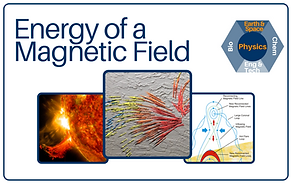Magna AR: Education
Planetary Magnetism
This lesson has students explore the magnetic field around a model Earth (a quasi-dipole field) and around a model Mars-like planet with an irregular, crustal magnetic field. Students learn about the role of magnetic fields in sustaining life.
Our project collaborated with the Temple University / AAPT NASA Space Science Education Consortium team to develop the "Modeling Planetary Magnetism" lesson using Magna AR. The lesson was tested with a group of educators in a workshop at the AAPT Winter Meeting 2020 in Orlando, FL to get feedback and refine activities.
Click on the teacher guide and student worksheet below (make a copy from Google Docs versions), or see the Digi Kit below from the AAPT to get the lesson and a series of vetted resources to contextualize the activity further.

Energy in a Magnetic Field and Solar Flares
This lesson has students explore the interactions between poles and consider where energy "goes" as they work to bring poles together or separate them. Students explore how field strength changes around poles that are near each other, and then apply this understanding of energy in fields to make conclusions about how stars release energy into space.
Our project collaborated with the Temple University / AAPT NASA Space Science Education Consortium team to develop the "Energy in a Magnetic Field" lesson using Magna AR. The lesson was demoed with a group of educators in a virtual workshop at the AAPT Summer Meeting 2020 in order to get feedback and refine activities.
Click on the teacher guide and student worksheet below (make a copy from Google Docs versions).

Explorations of Static Magnetic Fields
MAGNA AR can be used to explore a wide variety of physics scenarios of magnetic fields. Click the following links to see videos of example mapped 3-D fields:
Research Products
This project proposed to advance personal mobile technology to create a sensor-based visualization tool that addresses the challenges associated with introductory physics learners’ understandings about magnetic fields.
The intellectual merit of this project was to answer three core questions about technology and education research:
-
(RQ1) “What new technologies and associated developer resources for PMDs, such as ARCore for Android, can be created to enable 3D, real-time, sensor-based visualizations of physical fields?,”
-
(RQ2) “How do high school and college introductory physics learners use the technological tool to make sense of fields?,” and
-
(RQ3) “How do learners’ concepts of fields change as a result of using the new technological tool?”
To answer these questions, we employed two major research activities:
-
Interactive interview and observation protocols in which users interact with Magna AR and explain their thinking about magnetic fields.
-
Development of a conceptual inventory to measure changes in understanding about static magnetic fields, the MAGnetic kNowledge Assessment (MAGNA). This three-dimensional assessment and aims to uncover student thinking about the strength and direction of magnetic fields that surround Earth and permanent magnets.
Publications
Chapters
Vieyra, R., Megowan-Romanowicz, C., O’Brien, D. O., Vieyra Cortés, C., & Johnson-Glenberg, M. (2023, 01). Harnessing the digital science education revolution: Smartphone sensors as teaching tools. In S. Asim, J. Ellis, D. Slykhuis, & J. Trumble (Eds.), Theoretical and Practical Teaching Strategies for K-12 Science Education in the Digital Age. IGI Global. Link
Vieyra, R. & Vieyra, C. (2022, 04). Immersive learning experiences in augmented reality (AR): Visualizing and interacting with magnetic fields. In S. Macrine & J. Fugate (Eds.), Movement Matters: How Embodied Cognition Informs Teaching and Learning. Cambridge, MA: MIT Press. Link
Journal Articles
Vieyra, R. & López, R. (2023, 05). Physics in a space science context: Two learning sequences to teach about the properties of electromagnetic waves and fields. The Physics Teacher. Link
Assessment - MAGNA
The MAgnetic kNowledge Assessment (MAGNA) is a 16-item magnetic field test (preceded by a 5-item tutorial) that simulates the three-dimensional field around permanent magnets and the Earth.
To access this assessment, you must first have been granted a test account (if a teacher), or have been provided a user code by a teacher (if a student). For test results or further questions, contact us at support@vieyrasoftware.net.
MAGNA was developed by Dr. Colleen Megowan-Romanowicz (American Modeling Teachers Association), Dr. Mina C. Johnson-Glenberg (Arizona State University and Embodied Games Lab), Dr. Rebecca Vieyra (Vieyra Software), and NT Studio Team (Tempe, AZ). The test developers acknowledge useful conversations with Dr. Aakash Kumar, Dr. Ramón López, and Chrystian Vieyra.



